The Atomic Age - In CINERAMA | Read more at in70mm.com The 70mm Newsletter |
| Written by: North American Fieldman, December 1956, volume 13, No 10 | Date: 26.10.2010 |
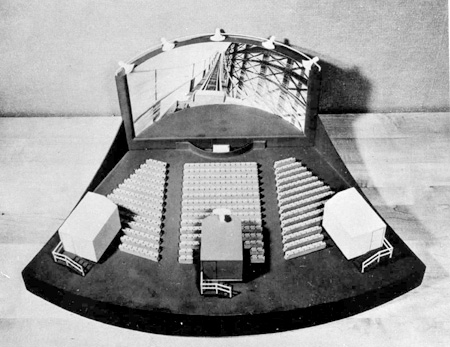 Scale model of
a typical Cinerama installation shows the three booths from which the three 35mm
films are projected, perfectly synchronized to reproduce the huge
picture on a semi-circular screen, almost six times the size of the average
motion picture theatre screen. The revolutionary stereophonic sound
effect is produced by the five horns which, in actual installation, are
behind the screen. Other sound units are on each side of and in the rear of
the theatre. Scale model of
a typical Cinerama installation shows the three booths from which the three 35mm
films are projected, perfectly synchronized to reproduce the huge
picture on a semi-circular screen, almost six times the size of the average
motion picture theatre screen. The revolutionary stereophonic sound
effect is produced by the five horns which, in actual installation, are
behind the screen. Other sound units are on each side of and in the rear of
the theatre.North America's $668,000 Floater Policy Covers Photographic Equipment Used to Make Pictures of World's Wonders The Atomic Age - In CINERAMA In the high mountainous country of Pakistan, India, bordering on the Himalayas, is the Indus River, the upper part of which is noted for its strong and swirling currents. In the middle of these rapids, last July 20, a boat containing eight men, a three-eyed Cinerama camera and other equipment necessary to "shoot the rapids", photographically, suddenly capsized. One of the men, James Parker, a 45 year old actor and adventurer was drowned. The other seven managed to reach the shore. The $45,000 camera and the boat were lost in the rushing waters. |
More in 70mm reading: in70mm.com's Cinerama page Internet link: |
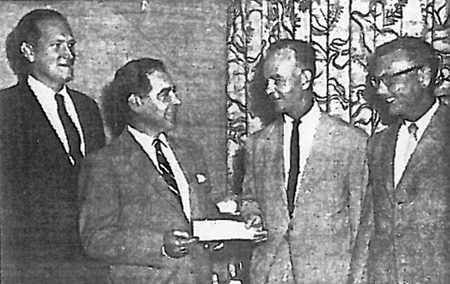 Charles Weaver (right center), Knox, Weaver and Company, presented a
check for $45,000 drawn on the Insurance Company of North America to
John Hartley, treasurer of Cinerama. Inc., in payment of the loss of
photographic equipment during the filming of "Search for Shangri-La" in
Pakistan. Others are Grant Leenhouts (left), vice president of
Cinerama, Inc. and John H Laub (far right), marine manager. Uptown New
York Office Insurance Company of North America. Charles Weaver (right center), Knox, Weaver and Company, presented a
check for $45,000 drawn on the Insurance Company of North America to
John Hartley, treasurer of Cinerama. Inc., in payment of the loss of
photographic equipment during the filming of "Search for Shangri-La" in
Pakistan. Others are Grant Leenhouts (left), vice president of
Cinerama, Inc. and John H Laub (far right), marine manager. Uptown New
York Office Insurance Company of North America.On July 23 the story of this unfortunate accident was published in newspapers in New York and elsewhere. The group included, besides Parker, Otto Lang, director; Jack Priestly, cameraman; Michael Zingale, assistant cameraman; Peter Passas, focus man; John Wallace, grip; and two rivermen from the Pacific Northwest, Bus and Don Hatch. This group of adventurers was engaged in shooting not only the rapids of the Indus, but a picture for Lowell Thomas's newest Cinerama travel feature "Search for Shangri-La". Since 1951 Insurance Company of North America has covered the cameras and other photographic equipment of Cinerama, Inc. under a worldwide Floater and other insurance. The schedule, perhaps the largest ever written, now amounts to $668,877. The policy was placed through Knox, Weaver and Company, Inc., New York City. The insurance first became effective while the Cinerama process was being developed, before the world knew about the revolutionary new process. Therefore, on July 23, A. H. Smith, manager of North America's New York Marine Claim and Loss Department, cabled James Finlay and Company, Ltd., Karachi, India, North America claims settling agents, as follows: | |
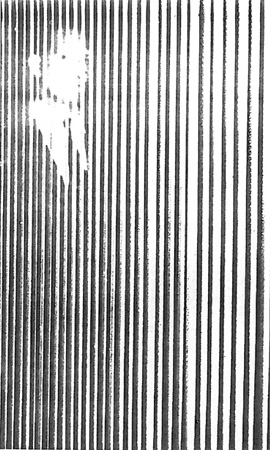 The
Cinerama screen consists of more than a thousand strips of perforated
tape arranged like the louvres of a gigantic Venetian blind, and
presents a solid front. The
Cinerama screen consists of more than a thousand strips of perforated
tape arranged like the louvres of a gigantic Venetian blind, and
presents a solid front."We insure camera equipment Cinerama, Inc. / Representatives located Flashmans Hotel Rawalpindi Pakistan / report received boat capsized upper Indus River drowning one man and loss of camera #5 / insured forty five thousand dollars / please verify with details lost equipment and salvage possibilities if any." On July 26th. the reply came back, saying in part: "Your tel relayed our Lahore Office / their representative visited Rawalpindi twenty fifth / cabled us / quote / contacted Evans Manager Cinerama, Inc. / accident occurred twentieth July in Upper Indus River Gilcit Valley / James Parker drowned seven persons survived / one camera number five and accessories lost / no salvage possible / one very strong current / unquote." The scene now shifts back to New York and the office of John Hartley, Treasurer of Cinerama, Inc. at 304 East 44th Street. The date is July 31st, just ten days after the unfortunate accident in the upper Indus River more than 8,000 miles away. Charles Weaver, of Knox, Weaver & Company, Inc., hands a check for $45,000 to Mr. Hartley in "partial payment" of the loss, since details of the value of the lost accessories are still missing. Present at that brief ceremony are Grant Leenhouts, Vice President of Cinerama, Inc., John H. Laub, Marine Manager of North America's Uptown New York Office, and an editor of the North America Fieldman. It was particularly appropriate that Mr. Weaver perform this duty, since he was a member of the North America family from 1935, when he joined the company as a trainee in the Ocean Marine Department, until 1946, at which time, after having served as special agent in the Uptown New York Office and in the Westchester (now White Plains) Office, he became a principal in the firm of Knox, Weaver and Co., Inc. At the meeting there was an opportunity to review the brief but startling history of Cinerama. Here is the story they tell: The late Fred Waller invented Cinerama as the result of a lifetime study of photography and a dream of recreating reality in such a dramatic way that the viewer would become a part of the picture It was Waller's understanding that we judge depth by the sight out of the corners of our eyes. Peripheral vision, he called it. But to bring this to a motion picture theatre, the screen would have to be literally a mile wide. Not until he collaborated on a display for the World's Fair of 1939 with architect Ralph Walker did Waller get a solution for this difficulty. He decided to curve the screen in the same way the retina of the eye is curved. | |
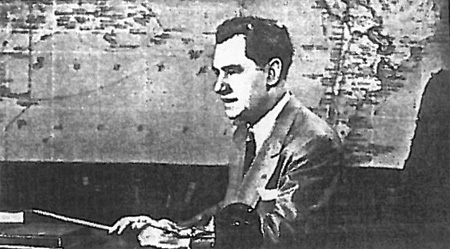 Lowell Thomas,
who opened the first production in the Cinerama process, "This is
Cinerama," is shown in his study at Pawling, N. Y. introducing "The
Seven Wonders of the World," which he produced with Stanley-Warner
Corporation. Mr. Thomas is currently supervising the production of
"Search for Shangri-La." Lowell Thomas,
who opened the first production in the Cinerama process, "This is
Cinerama," is shown in his study at Pawling, N. Y. introducing "The
Seven Wonders of the World," which he produced with Stanley-Warner
Corporation. Mr. Thomas is currently supervising the production of
"Search for Shangri-La."So with capital from Walker's firm, Voorhees, Walker, Foley and Smith, the Vitarama Corporation was formed to hold the basic Cinerama patents. Not only was the screen curved at this time, it had a dome that hung over the front of the audience. Eleven projectors were combined to throw the image on the screen, compared to the present three. The World's Fair never used the idea. It was considered too radical for their "world of the future." And before further development took place, Cinerama went to war. Cinerama principles were adapted into the Waller Flexible Gunnery Trainer. It was described as looking like the end of the Triborough Bridge with four men on it, their feet dangling in air, a console like a church organ, and behind that a whole jumble of wires and electronic equipment. But taken together, it simulated for trainees the feeling of combat conditions. Hits were recorded electronically. Most of these machines were used seven days a week, twenty-four hours a day throughout the war. The Air Force estimated that more than 250,000 casualties were averted through use of Waller's Gunnery Trainer. Reality, though, is as much a function of the ears as the eyes. This was Waller's conviction. And this was the lifework of Hazard Reeves. When he first saw Cinerama at a prewar test, he was excited. Here was the visual counterpart for his dreams of stereophonic sound realism. After the war, he set to work. He came up with a scheme that used seven soundtracks. When the film was taken, the sound would be tied to the object photographed. It would come from the place it did originally. Reeves called it "directional" sound. Finally, by the spring of 1949, the equipment was sufficiently developed to permit the showing of a few short demonstration films which had been made with the, now, three-eyed Cinerama camera. All the established theatre and motion picture people were called in for a look. It seemed too big for them. They were interested in keeping the business the way it was. | |
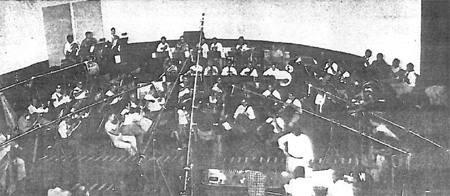 Half a dozen
microphones strategically spotted around the studio stereophonically
recorded the music of an all-star symphony orchestra on a
seven-channeled sound track, providing a higher fidelity of music
reproduction than ever before achieved in motion pictures. Half a dozen
microphones strategically spotted around the studio stereophonically
recorded the music of an all-star symphony orchestra on a
seven-channeled sound track, providing a higher fidelity of music
reproduction than ever before achieved in motion pictures.Casually, upon return from a trip to Tibet, Lowell Thomas dropped in to pay a social call on Hazard Reeves. He was told about Cinerama. He wanted to make the first Cinerama feature. He felt the tremendous sense of participation Cinerama gave its audience. Here, he believed, was a device for bringing a world of experience to the theatre. Bob Flaherty, the father of realistic movie adventure, the motion picture genius who made "Nanook of the North," "Moana" and "Louisiana Story," saw Cinerama at Thomas' request. He, too, found the answer to old dreams in Cinerama. But before he could take Waller's camera around the world, he died. Theatrical producer Michael Todd and his son filled in for him. They went to Europe and took Cinerama to Venice for a ride in a gondola, to the Spanish Bull ring, to Scotland for the Gathering of the Clans, and to La Scala Opera House in Milan where Cinerama was the first camera viewer of Verdi's "Aida." B. Wentworth Fling, an electronic genius, was brought into Cinerama, Inc. as executive vice president in charge of research, development and engineering. Then Merian C. Cooper, the producer of "King Kong," took over the American sequences. The three-eyed camera went to the aquatic wonderland of Florida's Cypress Gardens. Finally, stunt pilot Paul Mantz, the camera tied in the nose of his plane, zoomed across "America, the Beautiful." |
|
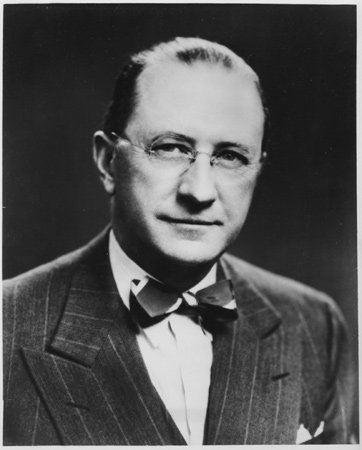 Fred
Waller, whose experiments with a three-lensed camera and a giant curved
screen resulted in the multidimensional Cinerama process which achieves
the effect of "putting the audience in the picture," died shortly after
the premier performance in 1952. Fred
Waller, whose experiments with a three-lensed camera and a giant curved
screen resulted in the multidimensional Cinerama process which achieves
the effect of "putting the audience in the picture," died shortly after
the premier performance in 1952.On Thursday night, September 30, 1952, "This is Cinerama" opened on Broadway. The moment Lowell Thomas recited the words, ". . . and now, Ladies and Gentlemen, 'This Is Cinerama,' " the distinguished audience knew it was witnessing the birth of a new era in entertainment. The curtain slowly drew back to reveal the expanse of screen, six times ordinary size. Then the audience was swept into action. It was in a roller coaster, diving and climbing, with thrills in the bottom of the stomach! The success of the first Cinerama film turned the whole motion picture and theatre exhibition industries upside down. Those who had rejected the process now began to imitate it with scopes and double negative systems and 55 mm film cameras and special magnified optical systems and multi-track sound recording. "This Is Cinerama," a travelogue without actors, without plot, using many scenes shot only for testing purposes, became and remained the Box Office champion week after week, even though showing in less than, a score of theatres. Successive pictures "Cinerama Holiday," produced by Louis de Rochemont, himself a pioneer in natural life news reel realism, had a thin story line. "Seven Wonders of the World," the current hit, was produced by Lowell Thomas and Stanley-Warner Corporation, which handles exhibition of the films. During all this time, North America insurance has covered the unique equipment developed for this process, the three-eyed cameras, the camera blimps, the generators, the microphone booms, the view finders, a variable metronome, lenses and, in fact, many items known only to Cinerama because they were devised by the inventors of the process and used only by Cinerama. During the whole period from the time Knox, Weaver and Company, Inc. first placed the insurance with North America, safety inspection service has been maintained, and many suggestions for safeguarding the valuable and sometimes irreplaceable equipment have been carried out. | |
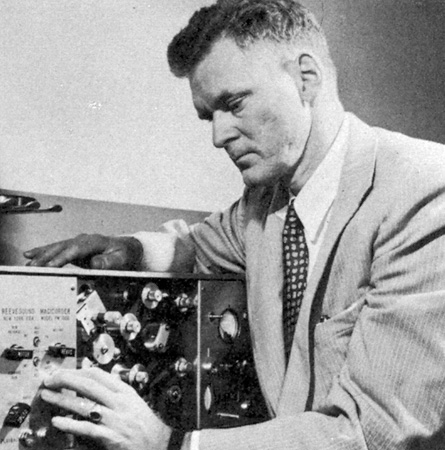 Hazard Reeves, whose seven
soundtrack system produced "directional sound" developed the Cinerama Sound process used in "This is Cinerama." Hazard Reeves, whose seven
soundtrack system produced "directional sound" developed the Cinerama Sound process used in "This is Cinerama."Some of these fascinating gadgets are located in laboratories, in an indoor tennis court in Oyster Bay, Long Island, in the sound studios on 44th Street, and in the various theatres where the pictures are being exhibited in the United States and presently in eight foreign countries. No major catastrophes have occurred due to the vigilance and care of Cinerama's staff and associates, until the recent tragic event in Pakistan. When you consider that airplane stunt flyer Paul Mantz strapped a camera to the nose of his famous twin engined B-25, which has served as a camera ship for the "America, the Beautiful" sequences of the first Cinerama feature and for many other famous shots and the thrilling sequences now being shot for "Search for Shangri-La," this is a remarkable record. Those in a position to know predict that, in Al Jolson's famous phrase, however, "you ain't seen nothin' yet"! A fifth Cinerama production, also now under way, will really blast audiences right out of their seats and maybe out of the theatre! Some sequences have already been made on a picture which has as its theme the Atoms for Peace proposal of President Eisenhower. | |
 Harry
Squires, Cinerama photographer, filmed many of the most dramatic
sequences of "This is Cinerama." He is shown threading the triple
magazines of the three-lensed camera which captures virtually the entire
range of human vision on its multiple film strips. Harry
Squires, Cinerama photographer, filmed many of the most dramatic
sequences of "This is Cinerama." He is shown threading the triple
magazines of the three-lensed camera which captures virtually the entire
range of human vision on its multiple film strips.Grant Leenhouts, Vice President of Cinerama, Inc. is in charge of this project. The title will be "The Eighth Day" and it will start where God left off, as related in the Book of Genesis. Leenhouts was identified with the early development of Cinerama. During World War II he was head of planning and production for the U. S. Navy Motion Picture Division. He has a long record of credits for productions at major studios and is a member of the Academy of Motion Picture Arts and Sciences. A "story board" in the Board Room at Cinerama, Inc. headquarters was shown to the writer and a tape recorded outline of the sequences was run off. We were assured that the outline had been changed and improved after the tape was made and that further refinements are being made as the shooting progresses. If no changes whatever are made, it will still be the world's most thrilling motion picture! "The Eighth Day" is the Atomic Age. Its start is the creation of the world with a voice reciting the early verses of Genesis, serving as a prelude to the introduction of the development of and the challenges brought about by the splitting of the atom. | |
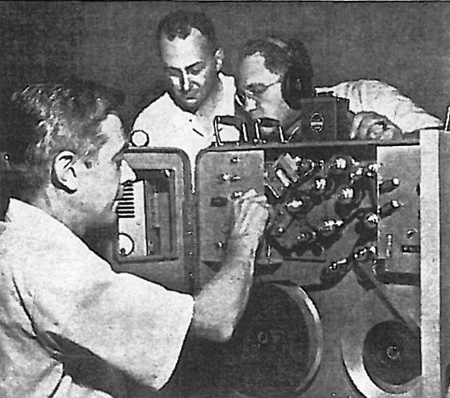 B.
Wentworth Fling (center), executive vice president in charge of
research, development and engineering, and fellow engineers load a
multiple-film Cinerama recorder. B.
Wentworth Fling (center), executive vice president in charge of
research, development and engineering, and fellow engineers load a
multiple-film Cinerama recorder.In the sequences that follow, the Cinerama cameras will show atom smashers being used to study the basic nature of matter, the work of nuclear energy for the benefit of mankind and the many applications of radioisotopes—the remarkable tracer atoms so useful in research. The film is being produced with the full cooperation of the Atomic Energy Commission, which has stated that this film could be a valuable national and international presentation to aid better understanding of the uses of the atom. In addition to being shown in the Cinerama process, the regular size 35mm prints will be made for showing in theatres not equipped for Cinerama. The AEC is giving assistance to Cinerama within security and operation limitations. Among the shots already made for the film are the launching of the "Seawolf," sister ship to the "Nautilus," the first atomic reactor-powered submarine, both of which are the subjects of North America Companies insurance protection. In making these sequences a Cinerama three-eyed camera (insured by North America) was in place on the deck of the Nautilus (liability for damage caused by atomic reactor insured by Indemnity Insurance Company of North America) as the boat submerged. So far the hazards, unusual as they are, inherent in making such pictures have not resulted in loss, except in the Pakistan incident. The outstanding thrill sequence of the new film will undoubtedly be the footage already made in the South Pacific Proving Grounds showing the explosion of a thermo-nuclear device during the summer of 1956. | |
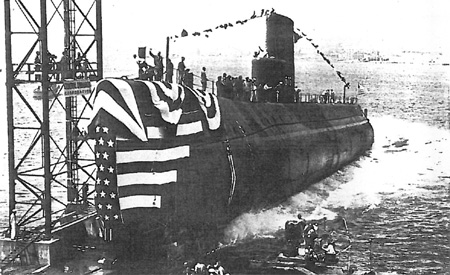 A
Cinerama camera (right foreground) shot the scenes of the launching of
The Sea Wolf, sister ship of The Nautilus, as a sequence for the
forthcoming Cinerama production, "The Eighth Day." Insurance coverage
for both of these atomic-powered submarines is provided by Indemnity
Insurance Company of North America. A
Cinerama camera (right foreground) shot the scenes of the launching of
The Sea Wolf, sister ship of The Nautilus, as a sequence for the
forthcoming Cinerama production, "The Eighth Day." Insurance coverage
for both of these atomic-powered submarines is provided by Indemnity
Insurance Company of North America.It has been revealed that the explosion was four miles from the target. This error, however, made the explosion occur four miles closer to the Cinerama three-eyed, seven-eared camera. When projected on the plastic Venetian blind type screen in theatres sometime next year, it is predicted that the blast will surpass anything yet witnessed by an audience! That is the reason a close-up of an atomic detonation is used as a cover picture on this month's issue of the North America Fieldman. It is fitting that North America Companies, pioneers in insuring atomic energy risks, should also be the insurers of the Cinerama cameras and equipment being used to film the story of the Atomic Age "The Eighth Day." Atomic energy is the key to the future. Progress must be made in research, in development of nuclear reactor power plants and in the use of by-products for medical diagnosis and treatment. This progress would not be possible without insurance—greater amounts of insurance than ever before required, because of the magnitude of the risk. Just as Cinerama has revolutionized the motion picture industry, so has the Atomic Age already brought about revolutionary changes in the concepts of underwriters with regard to atomic reactor risks. And as Cinerama has brought about a new dimension, a new audience participation, a new thrill to picture viewing, so the insurance industry must lead the way to enable great inventions, great discoveries, great advancements of science, to even higher achievement under freedom from the worry of loss because of insurable hazards. | |
| Go: back - top - back issues - news index Updated 22-01-25 |
